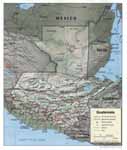
| 
|
| | |

| 
|
| | |
I cached three "bags" with TC in Punta Gorda -- my dive bag with all my dive gear and half my clothes, and my dive tanks. I figured I was going to have enough trouble dealing with my backpack, which contained mostly electronics like my laptop and camera; and my big orange Bill's bag (waterproof river bag), which contained my sextant, cruising guide and charts, and tools and parts for the boat. Then I took the daily boat that ran from Punta Gorda to Puerto Barrios. On the way over I was talking with a local, and realized that it was Christmas season and the busses would be full to overflowing with people traveling to who-knows-where for the holidays. Since I didn't want to be stuck in Puerto Barrios for the night, I decided to pay a little extra and took a taxi instead of a bus from Puerto Barrios to Rio Dulce. Subsequently I took the bus from Fronteras to Puerto Barrios and back when I needed to work on my spare alternator, and it was no big deal. But I was apprehensive, given all the stories I had heard about Puerto Barrios. This travel is shown in magenta on the Rio Dulce area map above.
I arrived in Fronteras, also known as Rio Dulce, just before Christmas, and was hoping to spend a few weeks fixing the boat and then head up to Belize in a liesurely manner, having another few weeks to get really familiar with her before having to rendezvous with friends and family. But the boat needed more work than I anticipated, or perhaps it was my lack of diesel engine skills that dragged things out. The few weeks stretched into five. In the end I had a boat I felt was sound enough to sail in fairly rough conditions, I had an engine and an outboard motor which worked, and I knew the boat inside out. Malakii and I were getting to know each other.
The Rio Dulce is a real introduction to Guatemala. It's not the safest place in the world, but it's not as bad as Puerto Barrios or Guatemala City, or at least so I've heard. It took me a while to feel comfortable walking around town, which I had to do constantly looking for boat parts.
The main highway, a two-lane affair, goes through the middle of town, as it does in most places in Central America. It is lined with street vendors, and on most mornings is a mass of humanity, even in a small town like Rio Dulce. I regret that I didn't take any pictures; something for next time. I was too focused on fixing the boat to relax and enjoy my surroundings very much.
The Rio Dulce is by far the best hurricane hole in the Caribbean. It is south of the hurricane belt, and the anchoring and docking areas are 25 or so miles inland, protected by the surrounding countryside. In addition, it is fresh water, which isn't nearly as hard on boats as salt water. As a consequence, there are lots of marinas. People leave their boats here permanently, or they leave them here for the hurricane season when they are just passing through. It is a great place to use as a base for exploring the interior of Guatemala. There is a good labor force on the Rio, and facilities for pulling boats out of the water for repairs. Unfortunately, the selection of Marine parts is not the best, and what there is is expensive.

|
| |
Christmas came and went with a wild barrage of fireworks, as did New Years. If you are a pyromaniac, go to Guatemala over the holidays. When I looked out from Malakii on Christmas Eve, I thought I was in a civil war battle. The smoke from fireworks rolled over the boats and the river like a thick fog.
Most stores in Rio Dulce are small shops whose proprietors sell whatever suits their fancy. So while a shop may be ostensibly a clothing store, they usually have kitchenware, oil filters, a few tools, maybe some CDs, and of course fireworks somewhere in the back. They probably also have some foodstuffs. The result is no matter what you are looking for, you usually have to meticulously inspect half the establishments in town before you find what you are looking for; and all of them to be sure it isn't available. It's horribly frustrating, but also kind of a treat, once you get the idea and calm down to where you aren't in a hurry. If you're a compulsive shopper, you probably love it, because it's like enforced window shopping.
As some examples, I found my oil filter at a bicycle shop, my kitchen skillet at a furniture store, my kitchen knife at a clothing store. Every time I wanted a piece of hose or some gasget material, I had to check out half the places in town which carried building supplies. Noone had a complete inventory of anything. When I wanted a particular wrench, or socket, I would go where I knew they sold stuff like that, and they wouldn't have the size I needed. However, it was great for improving my Spanish. Trying to describe to someone a universal joint for a socket is a challenge; writing tools are a big help!
The fresh produce was wonderful, and I would refill my pantry every few days. But I was amazed at what a poor selection of breadstuffs there was. In Livingston, 25 miles down the river at its mouth, you can get wonderful Coconut bread which tastes kind of like a sourdough; but nothing of the sort was routinely available in Rio Dulce that I found. I was delighted to notice a vendor had raisins. But when I ran out and went looking for them, no one had any. I noted it as something to buy when available no matter what. Fortunately, a week or so later they again showed up.
After about three weeks, Bill and Carol showed up. I had just gotten the engine running, and was ready to take Malakii out for her first sail. Our first attempt got cut short as the engine heated up and coolant boiled over, steam coming out everywhere. We got that problem diagnosed, and had a good shakedown sail the next day. We sailed up the river to Lake Izabal, and out into the lake. There is a fortress Castillo San Felipe, at the mouth of the lake, established to defend the entrance of Lake Izabal against pirates coming upriver from the Caribbean. It was originally built in 1595, and used throughout the 17th century. It was damaged and rebuilt on numerous occasions. We celebrated with Mike's Lemonade.

| 
|
| | |
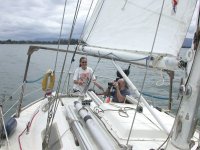
| 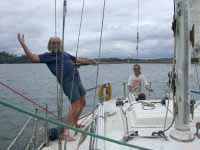
| 
| 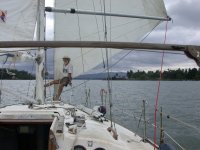
|
| | | | |
At the dock next to me was another boat, Sirocco, whose owner, Sebastian, was basically doing what I was -- buying a cheap boat and fixing it up. However, his boat was his only home, while mine was a vacation one. He speaks fluent Spanish, French, English, and I can't remember what else, and was a great help when I had trouble communicating. When I arrived, he had already been working on Sirocco for several months. She was getting to be in pretty good shape. She required a lot more work than Malakii, but will probably be a better boat for his purposes in the long run. Sebastian is a dive instructor by profession, and plans to use his boat in that capacity; I wish him well. We did a solo shake-down race against each other, a way to work some of our single-handing problems out away from the limelight.
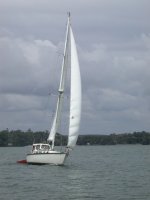
|
| |
At the end of January, I had about run out of time. I was supposed to meet my friend Lynde up in Chetumal on the 8th of February, and it was going to take a while to sail up there. Fortunately, Malakii was in pretty good shape by then. Or at least she seemed to be. I still had reservations about her engine, but I didn't know quite what I wanted to do about it.
So, on January 30 I pulled out of the marina I was staying in, hoisted sail, and headed down the river to Livingston. I'd traveled down the river in a power boat a week or so before to get my boat papers straightened out, so I had some idea of what lay ahead. But I'd never sailed it. It was the real start of my big adventure.
Soon I had put the marinas of Rio Dulce behind me, and I sailed out into the Golfete. The wind was not great, but it was enough to push me across. The lake narrowed and I slipped into the river again. From the Golfete to Livingston, the river enters a small canyon. It is a wild and interesting place. I would like to spend time exploring down there, but at the moment it is not considered safe. A few miles before Livingston the wind pretty much died, then I got hit by a big rainstorm. It was getting late, and I was concerned about getting to Livingston in time to check out of the country, so I could get an early start the next morning. I doused the sails and motored the last two miles. The next day, I headed back to Punta Gorda in Belize. (Yellow line on Rio Dulce area map at top of this page)

| 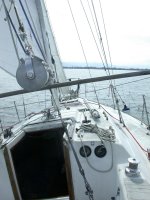
| 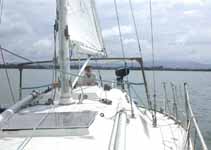
|
| | | |
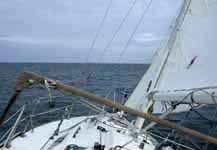
| 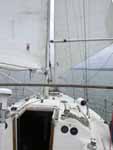
|
| | |
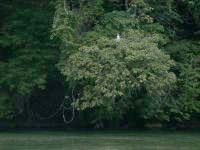
|
| |